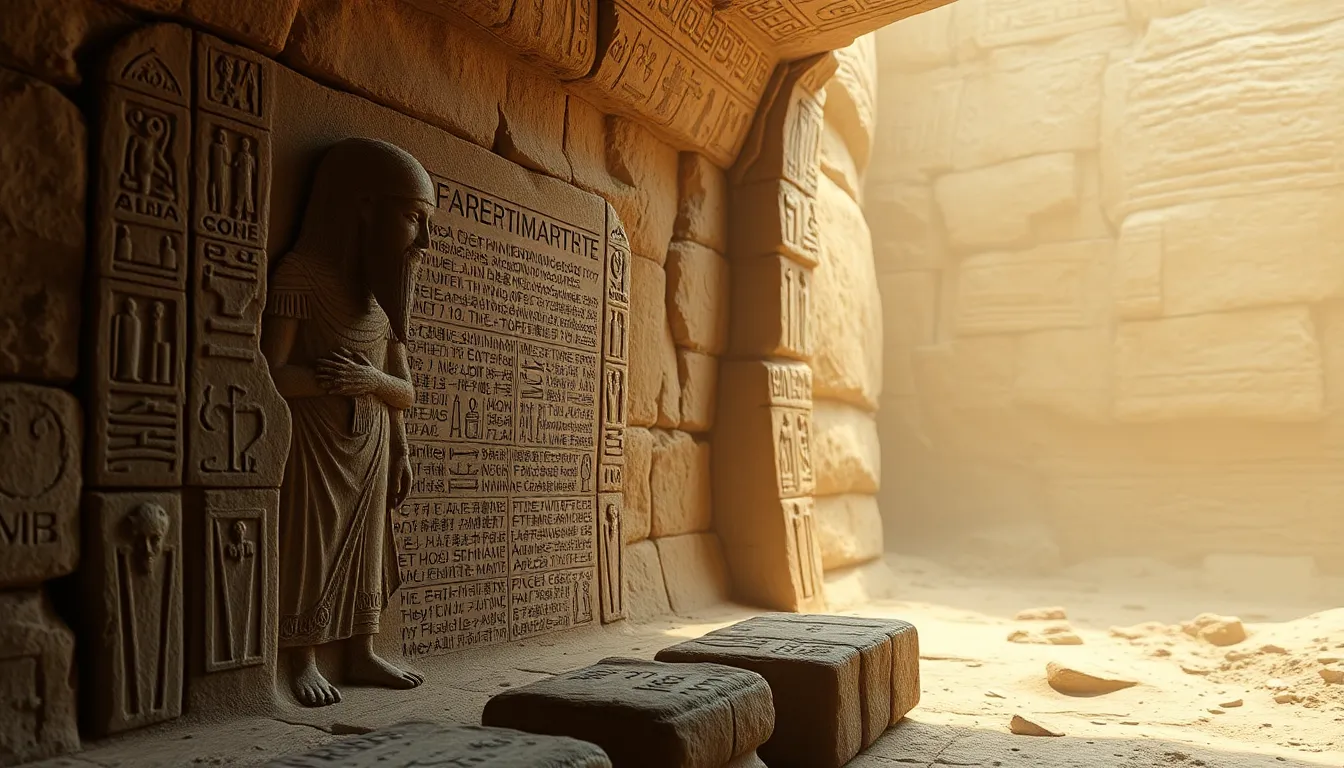Tomb Texts: The Voice of the Dead in Ancient Egypt
I. Introduction
Tomb texts are a significant aspect of ancient Egyptian funerary practices, serving as a means of communication between the living and the dead. These inscriptions, found in tombs and burial sites, provide insights into the beliefs and rituals surrounding death and the afterlife in ancient Egypt.
Ancient Egyptians held a rich tapestry of beliefs regarding the afterlife, viewing it as a continuation of life on earth. They believed that the deceased would embark on a journey to the afterlife, facing challenges and requiring protection from various deities. This article aims to explore the historical context, types, themes, and significance of tomb texts, illuminating their role in ancient Egyptian civilization.
II. Historical Context of Tomb Texts
The evolution of funerary texts in ancient Egypt spans from the Old Kingdom to the Ptolemaic period. Initially, these texts were exclusive to the pharaohs, gradually expanding to include nobility and commoners.
- Old Kingdom: Pyramid Texts emerged as the earliest collection of religious spells inscribed in the burial chambers of pharaohs.
- Middle Kingdom: Coffin Texts appeared, allowing non-royals to access similar protections and spells in their afterlife journey.
- New Kingdom: The Book of the Dead was developed, providing a comprehensive guide for the deceased and reflecting a more democratized approach to the afterlife.
Key historical figures, such as the pharaohs and priests, played vital roles in the development of these texts. Archaeological discoveries, including the tombs of Tutankhamun and the pyramids of Giza, have illuminated the use and significance of tomb texts in ancient Egyptian society.
III. Types of Tomb Texts
There are several distinct types of tomb texts, each serving different purposes and audiences:
A. Pyramid Texts
Pyramid Texts are the earliest examples of tomb inscriptions, primarily found in the pyramids of the Old Kingdom. They consist of spells and rituals designed to ensure the pharaoh’s safe passage to the afterlife.
B. Coffin Texts
As the Middle Kingdom unfolded, Coffin Texts emerged, marking a transition from royal exclusivity to broader accessibility. These texts were inscribed inside coffins and included spells that could be used by non-royals, indicating a shift in beliefs about the afterlife.
C. Book of the Dead
The Book of the Dead, developed during the New Kingdom, is perhaps the most famous of the tomb texts. It is a compilation of spells, prayers, and instructions organized in a flexible structure, allowing for personal adaptation. Variations of this text reflect individual beliefs and practices.
IV. Themes and Symbolism in Tomb Texts
Tomb texts are rich in themes and symbolism, reflecting the ancient Egyptians’ complex beliefs about the afterlife:
A. The Journey to the Afterlife
The texts often describe a perilous journey to the afterlife, filled with challenges such as encounters with demons and judgment before Osiris, the god of the underworld. Protective spells are common, providing the deceased with guidance and support.
B. Deities and Their Roles
Deities such as Osiris, Anubis, and Ra play significant roles in funerary beliefs. Each god has specific functions, from guiding the deceased to judging their worthiness for the afterlife.
C. Recurring Symbols
Common symbols found in tomb texts include:
- The Ankh: Representing life and immortality.
- The Scarab: Symbolizing rebirth and protection.
- The Feather of Ma’at: Associated with truth and justice, used in the weighing of the heart ceremony.
V. The Role of Tomb Texts in Funerary Practices
Tomb texts played a crucial role in ancient Egyptian funerary practices:
A. Burial Rituals
Tomb texts were recited during burial rituals, serving as a means to ensure the deceased’s safe passage and protection in the afterlife.
B. Relationship with Artifacts
The inscriptions on tomb walls and artifacts were interconnected, with objects often inscribed with spells intended to assist the deceased in their journey.
C. Inscriptions in Tomb Architecture
The significance of inscriptions extended to tomb architecture, where texts were often carved into walls, ensuring that the deceased would have access to their spells and prayers in the afterlife.
VI. The Voice of the Dead: Communication with the Living
The belief in the continued existence of the deceased is central to the concept of tomb texts:
A. Continued Existence
Ancient Egyptians believed that the spirit of the deceased would continue to exist and be active in the lives of the living, often requiring the latter to honor and communicate with them.
B. Dialogue Between the Dead and the Living
Tomb texts served as a dialogue, with the living reciting spells and prayers to invoke the presence of the deceased, maintaining a connection across the realms.
C. Ritual Practices
Ritual practices often included the recitation of tomb texts, reinforcing the relationship between the living and the dead during ceremonies and memorials.
VII. Influence of Tomb Texts on Later Cultures
The impact of Egyptian funerary texts extends beyond their own culture:
A. Influence on Neighboring Cultures
Egyptian funerary texts influenced neighboring cultures, with elements of their beliefs and practices being adopted by other civilizations in the region.
B. Adaptations in Later Religions
As religions evolved, some concepts from Egyptian funerary texts were adapted and reinterpreted, influencing the development of beliefs about the afterlife in various belief systems.
C. Legacy in Modern Egyptology
Today, tomb texts continue to captivate scholars and enthusiasts alike, forming a crucial part of modern Egyptology and influencing popular culture through literature and media.
VIII. Conclusion
In summary, tomb texts serve as a vital resource for understanding the beliefs and practices of ancient Egyptians regarding death and the afterlife. They illuminate the rich cultural tapestry of a civilization that placed immense importance on the journey beyond this life.
The enduring significance of tomb texts highlights their role in connecting life, death, and the voice of the dead, providing insights into how ancient Egyptians perceived existence beyond the physical realm. As we continue to explore these ancient texts, we deepen our understanding of a civilization that sought to bridge the gap between the living and the deceased.




